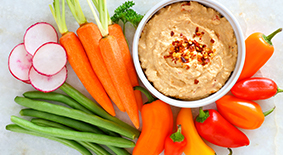Helpful Tips to Start Your Plant-Based Journey
Have you ever considered starting a plant-based diet? The Children’s Healthcare of Atlanta Strong4Life team shared the benefits of the diet and how to get started.
The Children’s Plant Strong series presented by the Strong4Life team is less about assigning a label to your diet and more about adding lots of fiber and nutrient-rich plant power to each meal. According to the American College of Lifestyle Medicine, a plant-based diet consists of mostly food from plants—think whole grains, vegetables, fruits, beans and legumes—with little to no animal products. Eating a diet made up mostly of plants encourages eating more whole foods and minimizes the intake of refined, ultra-processed foods.
There are many benefits to eating more whole, plant-based foods. But perhaps the most compelling reason to make this lifestyle change is preventing chronic illnesses. Did you know your lifestyle likely has more to do with your chance of developing coronary heart disease, high blood pressure and Type 2 diabetes than your genetics?
The two most impactful things you can do to minimize your risk for developing a chronic illness are to eat a healthier diet and be active. Evidence suggests that eating more whole, plant-based foods can help:
- Improve your cardiovascular health and lower your risk of heart disease.
- Reduce chronic inflammation, especially in mature adults.
- Lower your risk for developing Type 2 diabetes.
- Treat hypertension (high blood pressure).
- Improve your body mass index (BMI) or help you lose weight.
- Reduce the risk of developing depression and other psychological disorders.
If you’re just getting started with adding more plants to your diet, focus on making simple swaps, additions and replacements.
Add nutrient-rich, whole plant power- Fruit: bananas, berries, oranges, apples, avocados, tomatoes
- Vegetables: spinach, kale, peas, corn, bell peppers, eggplant
- Roots and tubers: potatoes, carrots, beets, parsnips, turnips, radishes
- Whole grains: brown rice, quinoa, oats, barley, whole wheat, millet
- Legumes: black beans, garbanzo beans (chickpeas), kidney beans, lentils, peas
- Nuts and seeds: almonds, peanuts, cashews, chia seeds, sunflower seeds
- Swap meat or fish for plant-based proteins like beans, seeds, nuts or grains. Try topping a salad with quinoa and lentils, or try tofu in place of poultry.
- Swap refined carbohydrates like white bread, white rice and pasta for whole-grain items. Expand your palate by trying a less familiar whole grain like farro or barley. Consider adding veggies to your favorite pasta dish by spiralizing a zucchini or sweet potato to make noodles.
Try a tiered approach when evaluating the food you and your family are eating. Assess where your daily eating falls currently, and think about ways you can make small changes. Here’s our suggestion:
- Tier 1 (whole, plant-based foods): Think fresh fruit, veggies, beans and whole grains. Try to make half your plate out of these non-starchy plant options at each meal. Minimally processed foods like hummus and peanut butter are also tasty and packed with healthy fats and protein.
- Tier 2 (processed plant foods and unprocessed animal foods): Think whole grain breads, meal bars, fish, eggs and low-fat dairy. Try to only eat these foods sometimes and in small amounts.
- Tier 3 (processed animal foods and ultra-processed foods): Think sausage, bacon, cheese, lunch meat, candy and white bread. Try to limit eating these foods.

Taking care of your physical wellness
We help physicians build a strong physical foundation by sharing tips and resources on how to eat well and move more.
Learn More

